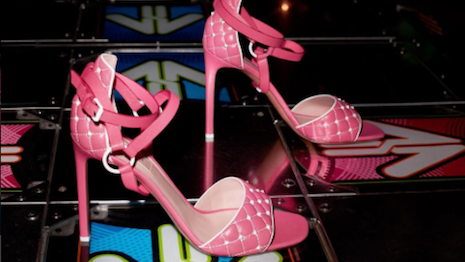 Valentino's #TokyoDiary included a game of Dance Dance Revolution. Image credit: Valentino
Valentino's #TokyoDiary included a game of Dance Dance Revolution. Image credit: Valentino
Italian fashion label Valentino is exploring Tokyo with the help of locals through a series of candid scenes.
Following Diary campaigns in both New York and London, the brand has chosen the Japanese city as its latest destination, capturing real people engaging in popular pastimes such as karaoke and video games. As consumers increasingly value authenticity, Valentino's ongoing pared-down efforts cater to this preference by featuring natural interactions.
"The Japanese have long been trailblazers of street fashion, especially Tokyo’s youth," said Lauren Bates, marketing manager and lead storyteller at BlueMoon Digital, Denver, Colorado. "Japanese fashion sense has always been about telling a story, and that can be seen with the way people dress in Harajuku, Tokyo’s eccentric youth culture neighborhood.
"And while most clothing is about how the individual wearer wants to express him or herself, in the west it is largely about how the clothing looks on the body," she said. "In Japan, that is really not the case. The clothing, in many cases, is the story and the wearer the vessel.
"Valentino sees this as an opportunity to not only leverage their 'clothing as a story' asthenic, but this has played brilliantly into Japan’s vibrant culture."
Ms. Bates is not affiliated with Valentino, but agreed to comment as an industry expert. Valentino was reached for comment.
Diary entry
Valentino’s #TokyoDiary was filmed by photographer Terry Richardson in July. Much like the previous campaigns, this focuses on highlighting “real people in real places.”
This latest iteration functions as a promotion for the brand’s latest Rockstud Spike collection of shoes and bags.
Along with snapping street style shots and the scenes in Tokyo, Mr. Richardson also got individuals on camera showing their singing or dancing skills.
A short film taken at Warehouse Kawasaki finds two teams competing in Dance Dance Revolution, a video game that requires the players to tap out prescribed routines with their feet on tiles of a platform. After introducing the competitors, the film documents their attempt to win as they dance in Valentino heels.
This organically showcases the footwear in the context of content, allowing the marketing to read more as entertainment.
A second video was filmed at the Karaoke Kan in Shibuya the following day. Taking turns, a group of individuals performs their own renditions of the 1978 pop song “Pensiero Stupendo” by Patty Pravo.
These impromptu performances allow the personalities of these individuals to come through, through both their actions and their personal style.
Valentino Garavani Rockstud Spike - Karaoke
Where possible, when sharing these films and photos on Instagram, Valentino also includes the handles of those featured. Many of the photographed have reposted the content to their own accounts.
A number of the chosen protagonists are influencers with thousands of followers, allowing Valentino to gain additional exposure in the local community.
"Embracing a culture’s favorite pastime is always a great way to be seen as a positive presence in a market," Ms. Bates said. "When a brand is relatable, through a cherished event or pastime, they already have an in, they are already seen in a favorable light because they have made themselves relatable.
"This touchpoint, through leveraging these campaigns on social, should be one of many," she said. "To say that this story, that these shorts, will drive commerce is probably a stretch. But, Valentino has laid the foundation for future interactions with this target audience of Japanese young people. They have gained a rapport as an outsider by making an effort to connect to the culture."
Model citizens
Taking social media's candid approach to content to heart, a number of brands have created film efforts that are more unplanned than scripted.
To market its All Love is Love bracelet around Valentine's Day, Versace created a film with a “man on the street” vibe, which shows people answering what they feel love is. All of the featured consumers wear the bracelet as they respond that love is happiness, wonderful, sexy and strength, with many speaking the brand’s All Love is Love phrase (see story).
Italian fashion label Dolce & Gabbana similarly put the marketing of its Lucia handbag in consumers’ hands.
For its “Who is Lucia?” series, the brand hit the streets of global cities, handing the bag to pedestrians and asking them to describe it in their own words. As consumers crave authenticity, hearing testimonials from real people may make for a more trustworthy advertisement (see story).
"The organic style and user generated content is something that millennials and Gen Zers love," Ms. Bates said. "This way these generations feel like they are a part of the story.
"And Valentino is speaking their language," she said. "In these shorts, Valentino uses many Japanese celebrities to really connect with the story, with the culture and with the youth of the nation—Ami and Aya have a combined 223K followers on Instagram, granted I am sure there is plenty of crossover between those followers, but the fact remains Valentino gets it.
"And while the current Valentino consumer, and most luxury consumers in general, might not relate to this format of engagement, the next generations will. And that is where they are, rightfully, focused as millennials are poised to outpace Boomers' spending power. So, by building this foundation Valentino is really positioning themselves for the future."